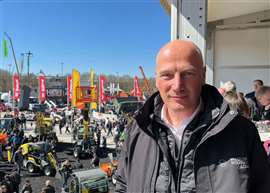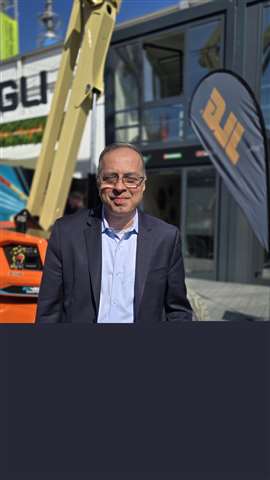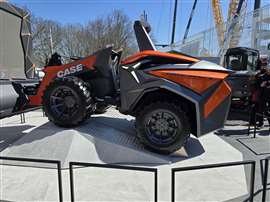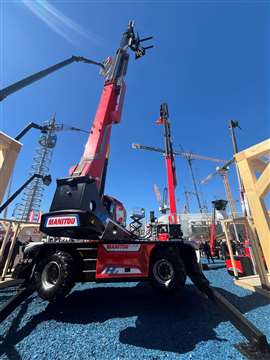Five key takeaways from Bauma
15 April 2025
Anticipation had been building for months leading up to the world’s largest construction trade show, which has secured itself as a must-attend event for the industry.
Attendance at last week’s Bauma reached around 600,000 visitors from more than 200 countries with exhibitors and industry leaders reporting a positive atmosphere and stating that the show could provide a real stimulus to the equipment industry.
 Bauma 2025 attracted ‘around 600,000’ visitors, confirming the show’s unrivalled status in the industry. (Photo: Messe Munchen)
Bauma 2025 attracted ‘around 600,000’ visitors, confirming the show’s unrivalled status in the industry. (Photo: Messe Munchen)
Joachim Schmid, managing director of the VDMA (the German Construction Machinery and Building Material Plants Association), said the show had been a “great success and in some cases exceeded the business expectations of our member companies.”
Show organiser Messe München said there were significant increases in visitor numbers, particularly from Brazil, Portugal, Romania, the Netherlands, Turkey and Spain. The numbers from China also increased again compared to the previous best attended pre-pandemic event in 2019, which saw around 620,000 visitors.
As one would expect, the cutting edge products on display were accompanied by an equally important range of issues affecting the rental and manufacturing sectors.
Trump’s tariffs dominate trade show talk
It was unsurprising that many OEMs attentions were on tariffs given the current landscape around Trump’s tariffs (in fact, by the time you read this it may have shifted further).
While the overall sentiment from exhibitors at Bauma was that of “wait and see”, some companies told IRN how they could pivot to alleviate the impact of potential tariffs.
For example, Wacker Neuson said it will accelerate its plan to produce mini excavators in the US following the tariffs imposed by the US administration.
 Alexander Greschner, chief sales officer (CSO), Wacker Neuson.
Alexander Greschner, chief sales officer (CSO), Wacker Neuson.
Alexander Greschner, chief sales officer (CSO) of Wacker Neuson, said it was aiming now to produce mini excavators in the 1.5 to 2.5t sizes in the US alongside the 3-5t machines that it was already preparing to manufacture under its manufacturing agreement with John Deere.
“We’ll localise”, he said, “If this is the reality of the future, then we have to be more American….obviously every American knows that from now on a European product might be more expensive.
“But at the very end, as a global group, say – with hypothetical numbers - if we make €500 million from Europe to the US today, 20% is €100 million.
“If we don’t do anything, this €100 million will be just gone from the profit line, so we have to look at it on a global scale as well and say, okay, we need to find ways to generate this money somewhere.”
However, the company did admit that there are likely to be pricing implications for customers which are hard to predict.
Greschner said the pricing impact in the US could be felt the most over the coming 9 months to a year, before its local production is fully online.
Spain-based genset and lighting tower manufacturer Himoinsa was one of the companies that took the “wait and see” stance, but Cristina Avilles, global marketing and communication head, told IRN that the company was slightly protected due to its manufacturing footprint in both Europe and the US.
This, she said, could enable the company to act quickly should any tariffs materialise.
Manufacturers are localising their production bases
A focus on localisation of production has been a key theme, particularly in the access industry, both leading up to and at Bauma.
Aside from Trump’s tariffs, which was the talk of the show, self-propelled aerial platforms imported to the EU from China are also now subject to tariffs following a ruling by the European Commission earlier this year. They follow similar tariffs imposed on MEWPs from China entering the US.
As a result, aerial lift manufacturers are restructuring their production footprints.
One of those, JLG has changed its strategy in recent months to adopt a Europe for Europe manufacturing approach and was at the show. Representing that approach on JLG’s stand was one of the company’s latest acquisitions, Italy-based Hinowa.
 Mahesh Narang, present, JLG, and Executive Vice President, Oshkosh.
Mahesh Narang, present, JLG, and Executive Vice President, Oshkosh.
Speaking to Access Briefing at Bauma, Mahesh Narang, present of JLG and Executive Vice President of parent company Oshkosh, said, “The message to us and other manufacturers was clear, make in Europe if you want to sell in Europe.”
As part of that Narang confirmed at the show that JLG has moved the production previously carried out in China to its four plants in Europe.
Those include two new electric boom lifts presented at Bauma, the EC450AJ Compact, and the newly launched EC660AJ rough terrain boom, developed and produced at JLG’s Hinowa facility.
Narang ads that localizing these products has taken very little investment or time. “We don’t need to expand the footprint much, we just need to acocyae where we do warehousing and I think we have enough space”
The price of the equipment will also remain consistent, “We found we could be cost neutral…by saving on logistics. So, we were able to provide a machine made in Europe at about the same price,” says Narang.
The localisaton philosophy is set to expand globally. “Longer term all our products for the US will be made in the US and all the products for Asia will be made in China.”
Narang, concluded, “We have changed our strategy. We are going local for local and longer term I think that’s a better strategy.
“We feel in a much better situation now to deal with all the changing tariff situations in the world.”
As part of its Made in Europe for Europe strategy, China-based Sinoboom announced at the show it had acquired scissor lift specialist Holland Lift.
Holland Lift went into liquidation in August 2023, citing numerous industry challenges, including higher running costs and severe supply chain issues and noted fierce competition from “low price newcomers”.
Now Sinoboom has taken ownership of the brand and its intellectual property, through its Netherlands subsidiary Sinoboom BV.
The Holland Lift portfolio includes over 30 models with working heights from 16m to 34m, with an emphasis on high capacities exceeding 1,000kg. They will be produced at Sinoboom BV’s plant in Poznan, Poland, which will now only produce products for Europe.
Susan Xu, CEO of Sinoboom Group, said, “This milestone supports our long-term objectives of product diversification and deepening our European presence. The Holland Lift Brand is recognized globally and has been a leader in the large scissor lift sector both in construction and industrial sectors.”
Zoomlion, which is also based in China, is investing €100 million in technology at a new factory in Hungary to start MEWP production in Europe, after it struck a deal to relocate its operations in the country.
Zoomlion has been present in Hungary since 2021 but has now reached an agreement with developer CTP for a 10-year lease on a new site at CTPark Tatabánya, to the west of Budapest.
At Bauma, Ren Huili, Vice President of Zoomlion and General Manager of Zoomlion Access, told access briefing that the company would also be extending this to the US.
Ren said the company is considering acquiring a manufacturer in the US or setting up new manufacturing facilities there itself. If Zoomlion did choose the acquisition route, Ren said it would choose a smaller OEM and expand from there. He confirmed that talks were currently underway with at least one supplier.
Autonomy on show
While the focus of many was on alternative power, the drive towards a future with autonomous machinery was also a standout.
Take for example Case Construction, which presented a concept for an autonomous electric compact wheel loader.
The electric Impact machine is based on its eCWL 12EV wheel loader and replaces the traditional operator cabin with remote control functionality via a dedicated control lounge.
 Case Construction’s autonomous electric compact wheel loader concept. The electric Impact machine is based on its eCWL 12EV wheel loader
Case Construction’s autonomous electric compact wheel loader concept. The electric Impact machine is based on its eCWL 12EV wheel loader
The design is intended to support operation in challenging environments and weather conditions, while also offering a more accessible solution for operators with motor impairments.
The concept includes an integrated perception system that uses real-time data to support machine operation, along with semi-autonomous features for digging and dumping. These elements aim to improve consistency and efficiency during use, the company said.
IRN was told that while the company does intend to make it a commercial unit, it has not set a timeline.
Hitachi Construction Machinery Europe also used Bauma 2025 to present autonomous adoption with its LANDCROS One, a concept excavator that combines AI, remote operation, and multiple power options.
Developed with mobility design studio Granstudio, the machine introduces what Hitachi calls a “phygital” approach – combining physical controls with digital interfaces to create a more intuitive operating environment.
The concept is designed with three operating modes: manual (with AI assistance), autonomous (for repetitive tasks), and remote (allowing operation from off-site locations). It also supports electric, combustion, and hydrogen power systems, reflecting a flexible approach to jobsite requirements and energy use.
Hitachi says the concept aims to support operators by reducing routine tasks, increasing flexibility, and enabling remote operation across time zones. The cab design includes modular elements and user-focused ergonomics, with a goal of appealing to a wider range of users.
While still in concept stage, LANDCROS One is intended to reflect Hitachi’s thinking around future construction site needs and how equipment can integrate more closely with digital tools and processes.
Meanwhile, HD Hyundai XiteSolution (HDX), the parent company of HD Hyundai Infracore and Develon, announced a new collaboration with Gravis Robotics and building materials group Holcim to advance the development of autonomous equipment for quarrying and materials handling.
The partnership will focus on deploying Develon machines across Holcim sites for a range of tasks, including truck loading, feeding crushers and screeners, handling materials in confined areas, and managing stockyards. Holcim’s goals include improving productivity, increasing safety, and optimising machine usage based on cost and performance.
Gravis Robotics will work alongside HDX to develop and apply the autonomous technology, while Holcim will support its implementation at operational sites, with the intention of scaling the system across its global network.
Sustainability was a key concern
One of Bauma’s key themes was sustainability, and as such the showground was awash with new energy equipment.
It was clear among the access equipment products that manufacturers are expanding their ranges to provide a wide choice. This means all popular models being available as electric, hybrid or diesel versions, depending on customers’ needs and, for example, the availability of charging infrastructure in any given country.
Apart from JLG’s previously mentioned electric booms, Skyjack has expanded its electric E-Boom range, launched last year, with the first hybrid RT boom models in the series presented at Bauma.
Available with 51ft (15.7m) and 66ft (20.1m) working heights and suitable for indoor and outdoor use, the articulating SJ45 AJHE + and SJ60 AJHE + models include the design features seen on the full electric versions.
Many of the Chinese manufacturers are already well advanced in their offering across diesel, electric and hybrid, and at the show Dingli was debuting products with mild-hybrid technology, including 22m and 18m scissors. The company, along with others, sees hybrid as a practical option in countries whihc are keen to expand their zero-emission offerings but are not in a position to roll out full elctric fleets.
The mild hybrid solution allows the lithium battery to be used as a starter battery, meanwhile, the engine can also charge the battery during daily operation. In complex working conditions, the lithium battery will provide additional torque output, saving energy and offering optimum power output.
XCMG displayed its new hybrid XGA20H articulating boom lift at the show, which offers an electric engine with a diesel-powered range extender. The model has a large load capacity of 320kg and is suitable for indoor and outdoor working conditions. Using the range extender gives 20 days of full use.
 The Manitou MRT 2260 H2 with hydrogen fuel cell technology.
The Manitou MRT 2260 H2 with hydrogen fuel cell technology.
Following the low emission path, XCMG had the new XT2506E lightweight compact electric telehandler on its stand. It is designed for enclosed spaces, like livestock sheds, vegetable processing plants, hospitals and schools and has a range of attachments.
Telehandlers were a focus on Manitou Group’s stand too, with an expanded electric range and a new hydrogen-powered prototype at Bauma.
The MRT 2260 H2 is powered by a hydrogen fuel cell and offers a lifting height of 22m and a load capacity of 6 tonnes. It incorporates a hydrogen-powered range extender that is easily removable and essentially replaces the diesel range extender found on hybrid MRTs.
Two new MT 1440e and MT 1840e electric telehandlers were also on the stand, powered by a lithium-ion 63 kWh battery that allows the machine to work for a full day. According to the company the electric system improves the total cost of ownership by 75% compared with combustion models.
Electric solutions can also be found in the largest of lifts. Bronto Skylift presented the world’s first 56m working height all-electric truck mount at the show. The combination of electric platform and chassis has been created in partnership with Swiss cleaning services company Rohr and Volvo Group subsidiary Designwerk Technologies AG, which is a pioneer in electric vehicles and has supplied the truck chassis.
There’s still huge demand for in-person trade shows
If the last five years have taught us anything, it’s that the appetite for face-to-face events remains strong. Despite the rise of digital alternatives during the pandemic, Bauma 2025 showed that in-person exhibitions continue to play a key role in the construction equipment industry—not just for showcasing machinery, but for fostering relationships, exchanging ideas, and seeing new technologies in action.
Major exhibitors and show organiser Messe München reported a successful event, with attendance reaching around 600,000 visitors from more than 200 countries. Many OEMs and industry representatives noted that the physical format of Bauma created space for genuine conversations and engagement that are hard to replicate in virtual settings.
Some 3,601 exhibitors from 57 countries attended, highlighting themes including sustainability, digitalisation, and autonomy—reflecting the pace of electrification and the challenges facing the industry.
Stefan Rummel, CEO of Messe München, summed up the event, “We hosted around 600,000 visitors from more than 200 countries and regions. Bauma is the heartbeat of the industry and has once again shown how crucial exchange and personal encounters are for progress and global trade.
“The Munich exhibition centre sends out a strong signal of confidence for the entire industry.”
STAY CONNECTED



Receive the information you need when you need it through our world-leading magazines, newsletters and daily briefings.
CONNECT WITH THE TEAM








